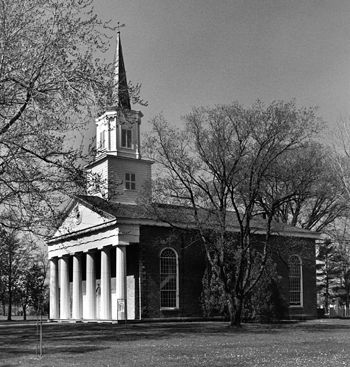Browse "Religion"
-
Article
Missions and Missionaries
In New France as elsewhere the christianization of the Indigenous population was an ostensible motive for European occupation, and trading companies and governors were under official pressure to provide it. The actual work was left largely to religious orders and societies.
"https://d2ttikhf7xbzbs.cloudfront.net/media/media/c5b4d6ed-9fa4-4675-b8de-1af6e5cc9567.jpg" // resources/views/front/categories/view.blade.php
https://d2ttikhf7xbzbs.cloudfront.net/media/media/c5b4d6ed-9fa4-4675-b8de-1af6e5cc9567.jpg
-
Article
Moravian Missions in Labrador
In 1771, Moravian missionaries were the first Europeans to settle in Labrador. Over a 133-year period, they established a series of eight missions along the coast which became the focus of religious, social and economic activities for the Inuit who gradually came to settle near the communities. Moravians had a huge impact on the life and culture of Labrador Inuit. What emerged was a unique culture rooted in Inuit traditions with indigenized European practices. The last Moravian missionary left Labrador in 2005, but the Moravian church, its customs and traditions are still very much alive in Labrador.
"https://d2ttikhf7xbzbs.cloudfront.net/media/new_article_images/MoravianMissionsinCanada/Eine-Schulergrupper-in-Nain-Resized.jpg" // resources/views/front/categories/view.blade.php
https://d2ttikhf7xbzbs.cloudfront.net/media/new_article_images/MoravianMissionsinCanada/Eine-Schulergrupper-in-Nain-Resized.jpg
-
Article
Mormon Church
The Mormon Church was founded in 1830 in upstate New York. The Church of Jesus Christ of Latter-day Saints, by far the largest Mormon denomination, is the only one of significance in Canada. There are currently eight Mormon temples in Canada.
"https://d2ttikhf7xbzbs.cloudfront.net/media/Cardston_Temple.jpg" // resources/views/front/categories/view.blade.php
https://d2ttikhf7xbzbs.cloudfront.net/media/Cardston_Temple.jpg
-
Article
New Brunswick Schools Question
In May 1871, the government of New Brunswick, under George Luther Hatheway, passed the Common Schools Act. This statute provided for free standardized education throughout the province, the establishment of new school districts, the construction of schools, and stricter requirements regarding teaching certificates. This law also made all schools non-denominational, so that the teaching of the Roman Catholic catechism was prohibited.
"https://d2ttikhf7xbzbs.cloudfront.net/media/media/d005fd0d-1dd4-4978-ae03-8c60a004c777.JPG" // resources/views/front/categories/view.blade.php
https://d2ttikhf7xbzbs.cloudfront.net/media/media/d005fd0d-1dd4-4978-ae03-8c60a004c777.JPG -
Article
New Religious Movements
New Religious MovementsCults or New ReligionsThe complexity of the subject has led scholars to abandon the popular term "cult" - which became associated with the 1978 People's Temple mass suicide/murders in Jonestown, Guyana; the Waco tragedy; the Solar Temple murders in Québec and Switzerland; and similar events worldwide - in favour of the more neutral term "New Religious Movements." In the sociology of religion terms like "church," "sect," "denomination," and "cult" have specialized meanings identifying...
"https://development.thecanadianencyclopedia.ca/images/tce_placeholder.jpg?v=e9dca980c9bdb3aa11e832e7ea94f5d9" // resources/views/front/categories/view.blade.php
https://development.thecanadianencyclopedia.ca/images/tce_placeholder.jpg?v=e9dca980c9bdb3aa11e832e7ea94f5d9
-
Macleans
Newfoundland Votes Down Church Schools
This article was originally published in Maclean’s magazine on September 18, 1995. Partner content is not updated.
"https://development.thecanadianencyclopedia.ca/images/tce_placeholder.jpg?v=e9dca980c9bdb3aa11e832e7ea94f5d9" // resources/views/front/categories/view.blade.php
https://development.thecanadianencyclopedia.ca/images/tce_placeholder.jpg?v=e9dca980c9bdb3aa11e832e7ea94f5d9
-
Article
Orthodox Church
Orthodox Church, also commonly known as the Eastern, Greek or Byzantine Church, a family of Christian churches historically found in eastern Europe, the Near East, Africa and Asia (see CHRISTIANITY).
"https://development.thecanadianencyclopedia.ca/images/tce_placeholder.jpg?v=e9dca980c9bdb3aa11e832e7ea94f5d9" // resources/views/front/categories/view.blade.php
https://development.thecanadianencyclopedia.ca/images/tce_placeholder.jpg?v=e9dca980c9bdb3aa11e832e7ea94f5d9
-
Article
Pentecostal Movement in Canada
The Pentecostal movement, also known as Pentecostalism, is a charismatic faith known for expressions of the Holy Spirit through its members. According to the Pentecostal Assemblies of Canada, the largest Pentecostal denomination in Canada, around 235,000 people attend services in more than 40 languages across the country.
"https://d2ttikhf7xbzbs.cloudfront.net/media/media/47db968f-4d14-4bb4-85ca-59fe98aca6be.jpg" // resources/views/front/categories/view.blade.php
https://d2ttikhf7xbzbs.cloudfront.net/media/media/47db968f-4d14-4bb4-85ca-59fe98aca6be.jpg
-
Article
Precious Blood Roman Catholic Church
The Église du Précieux Sang, built between 1967 and 1969 in St. Boniface, Manitoba, was designed by Étienne-Joseph Gaboury, of Gaboury, Lussier, Sigurdson Architects.
"https://development.thecanadianencyclopedia.ca/images/tce_placeholder.jpg?v=e9dca980c9bdb3aa11e832e7ea94f5d9" // resources/views/front/categories/view.blade.php
https://development.thecanadianencyclopedia.ca/images/tce_placeholder.jpg?v=e9dca980c9bdb3aa11e832e7ea94f5d9
-
Article
Presbyterian and Reformed Churches in Canada
All Christian churches of the "Reformed" tradition derive from the 16th-century Protestant Reformation and from Calvinism. Early Scottish settlers brought Presbyterianism to the Maritimes and central Canada in the late 18th century. In the 2011 National Household Survey (NHS), 472,385 Canadians identified as Presbyterian.
"https://d2ttikhf7xbzbs.cloudfront.net/media/media/a32c328a-2914-4151-88f8-78752391e954.jpg" // resources/views/front/categories/view.blade.php
https://d2ttikhf7xbzbs.cloudfront.net/media/media/a32c328a-2914-4151-88f8-78752391e954.jpg
-
Article
Protestantism
When a carefully engineered Catholic majority voted down certain reforms at the Diet of Speyer in Germany in 1529, the defeated minority earned the name "Protestant," derived from the Latin phrase meaning "to testify in favour of something.
"https://d2ttikhf7xbzbs.cloudfront.net/media/media/30714712-4e41-49c8-b7a6-da44f6fb0b80.jpg" // resources/views/front/categories/view.blade.php
https://d2ttikhf7xbzbs.cloudfront.net/media/media/30714712-4e41-49c8-b7a6-da44f6fb0b80.jpg
-
Article
Religion
Religion (from the Latin, religio, "respect for what is sacred") may be defined as the relationship between human beings and their transcendent source of value.
"https://d2ttikhf7xbzbs.cloudfront.net/media/media/cc179a05-9b3b-4d2c-aaf3-a1694d4f5288.jpg" // resources/views/front/categories/view.blade.php
https://d2ttikhf7xbzbs.cloudfront.net/media/media/cc179a05-9b3b-4d2c-aaf3-a1694d4f5288.jpg
-
Article
Religion and Spirituality of Indigenous Peoples in Canada
First Nation, Métis and Inuit religions in Canada vary widely and consist of complex social and cultural customs for addressing the sacred and the supernatural. The influence of Christianity — through settlers, missionaries and government policy — significantly altered life for Indigenous peoples. In some communities, this resulted in hybridized religious practices; while in others, European religion replaced traditional spiritual practices entirely. Though historically suppressed by colonial administrators and missionaries, especially from the late 19th- to mid-20th centuries, many contemporary Indigenous communities have revived, or continue to practice, traditional spirituality.
"https://d2ttikhf7xbzbs.cloudfront.net/media/media/f28b1ded-47a2-459d-9bfc-b26382f5c3b6.jpg" // resources/views/front/categories/view.blade.php
https://d2ttikhf7xbzbs.cloudfront.net/media/media/f28b1ded-47a2-459d-9bfc-b26382f5c3b6.jpg
-
Article
Religions and Music
Religions and Music. The many religions of Canada are touched upon in numerous articles in the Encyclopedia of Music in Canada (EMC).
"https://development.thecanadianencyclopedia.ca/images/tce_placeholder.jpg?v=e9dca980c9bdb3aa11e832e7ea94f5d9" // resources/views/front/categories/view.blade.php
https://development.thecanadianencyclopedia.ca/images/tce_placeholder.jpg?v=e9dca980c9bdb3aa11e832e7ea94f5d9
-
Article
Church Architecture
Later in the 17th century, under Jesuit influence and with the arrival of more artisans and builders trained in France, certain traditional features of religious architecture were used to construct churches in Québec City and Montréal.
"https://d2ttikhf7xbzbs.cloudfront.net/media/media/dc54dcff-f3dd-4f2c-b5ec-0ad5078ee2b2.jpg" // resources/views/front/categories/view.blade.php
https://d2ttikhf7xbzbs.cloudfront.net/media/media/dc54dcff-f3dd-4f2c-b5ec-0ad5078ee2b2.jpg

